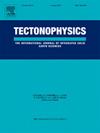马尔马拉地区新的gps速度场:对北安那托利亚断裂带运动学的影响
IF 2.6
3区 地球科学
Q2 GEOCHEMISTRY & GEOPHYSICS
引用次数: 0
摘要
北安纳托利亚断裂带(NAFZ)是一个主要的走滑断层系统,从土耳其东部延伸到爱琴海西部,约1200 公里,适应安纳托利亚和欧亚板块之间的相对运动。尽管在上个世纪NAFZ沿线发生了几次大地震,但自1766年以来,马尔马拉海下方的北部地区一直没有地震,这引起了人们对未来地震危险的担忧。以1912年和1999年的断裂为界的约160公里长的地震间隙,由于过去两个世纪的显著应变积累,被认为具有未来M >; 7级地震的潜在成核。本文章由计算机程序翻译,如有差异,请以英文原文为准。
New GPS-derived velocity field for Marmara region: Implications for the kinematics along the North Anatolian Fault Zone
The North Anatolian Fault Zone (NAFZ) is a major strike-slip fault system accommodating the relative motion between the Anatolian and Eurasian plates, extending approximately 1200 km from eastern Turkey to the Aegean Sea in the west. Despite several large earthquakes along the NAFZ during the last century, the northern strand beneath the Sea of Marmara has been seismically silent since the 1766 events, raising concerns about future seismic hazards. The ∼160-km-long seismic gap, bounded by the 1912 and 1999 ruptures, is considered to have a potential nucleation for a future M > 7 earthquake due to significant strain accumulation over the past two centuries.
While previous studies have provided valuable insights into the geometry and deformation patterns of the NAFZ in the Marmara region, discrepancies remain regarding the fault coupling and slip behavior of its submarine segments. The sparse onshore geodetic data, particularly on the northern side of the fault, and limited offshore geodetic observations hinder the ability to entirely resolve fault kinematics and slip characteristics along the northern strand in the Sea of Marmara.
To address these limitations, we established a high-spatial-resolution GPS network with both permanent stations and benchmarks, enabling a better understanding of the submarine segment's behavior and seismic potential by investigating the interseismic deformations along the NAFZ segments beneath the Sea of Marmara. Using the recent interseismic GPS velocities, we applied a block model inversion to estimate fault slip rates and coupling ratios along the northern strand of the NAFZ. The checkerboard tests indicate the robustness of our results.
This study provides new geodetic constraints that improve our understanding of the seismic potential of the NAFZ beneath the Sea of Marmara, offering critical insights for seismic hazard mitigation in the İstanbul metropolitan area.
求助全文
通过发布文献求助,成功后即可免费获取论文全文。
去求助
来源期刊

Tectonophysics
地学-地球化学与地球物理
CiteScore
4.90
自引率
6.90%
发文量
300
审稿时长
6 months
期刊介绍:
The prime focus of Tectonophysics will be high-impact original research and reviews in the fields of kinematics, structure, composition, and dynamics of the solid arth at all scales. Tectonophysics particularly encourages submission of papers based on the integration of a multitude of geophysical, geological, geochemical, geodynamic, and geotectonic methods
 求助内容:
求助内容: 应助结果提醒方式:
应助结果提醒方式:


